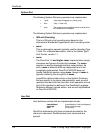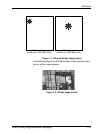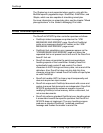
PostScript
Guide to Using Page Description Languages 1-15
The terms “write-white” and “write-black” are broad
generalizations. The specific print imaging characteristics of
some products may not represent other products with the same
write-white or write-black classification. For example, the
HewlettPackard (HP) LaserJet and the LaserWriter II NTX use a
write-black laser printer engine that uses the laser beam to
“write” where dry ink should go. Therefore, single pixel dry ink
dots are approximately round and are visible on an HP LaserJet.
In contrast, write-white laser printer engines “write” the dry ink
free areas, which can create single dots that have four concave
sides.
It is important to distinguish the fast scan direction, which is the
direction the laser beam moves across the page before jumping
back to do the next line. Remember that a laser printer scans a
page in a raster method, just like a television set. Fast scan
directions are not the same for a LaserWriter and the Xerox
engine.
In general, when turning on the same pixels, the write-white
engine produces output that appears lighter than output
produced by a write-black engine. Xerox device-parameterized
PostScript interpreters are able to partially compensate for this
by rendering thicker strokes and fonts. Device-dependent
PostScript cannot be compensated for because it is sending
user-created bit images instead of mathematical descriptions of
the desired output.
• User-defined PostScript fonts—Some user-defined fonts use
bitmaps that are tuned to write-black engines. These fonts
appear light on certain write-white printers.
• Image data at output device resolution—PostScript image
data that has a resolution matching the output device is
typically transferred directly to the frame buffer with no
modification. These images appear light on certain write-
white printers.
Black lines on a color background print white—PostScript (or
PCL) jobs that have black lines on a color background will
print the lines with white borders. This is a characteristic of
write-white printing.
• Single-pixel fills—Single isolated dots are visible on a
LaserWriter but not on some write-white printers; therefore,
single-pixel isolated fills in PostScript may not be visible on
your product.


















